| 1 | Green tree python |
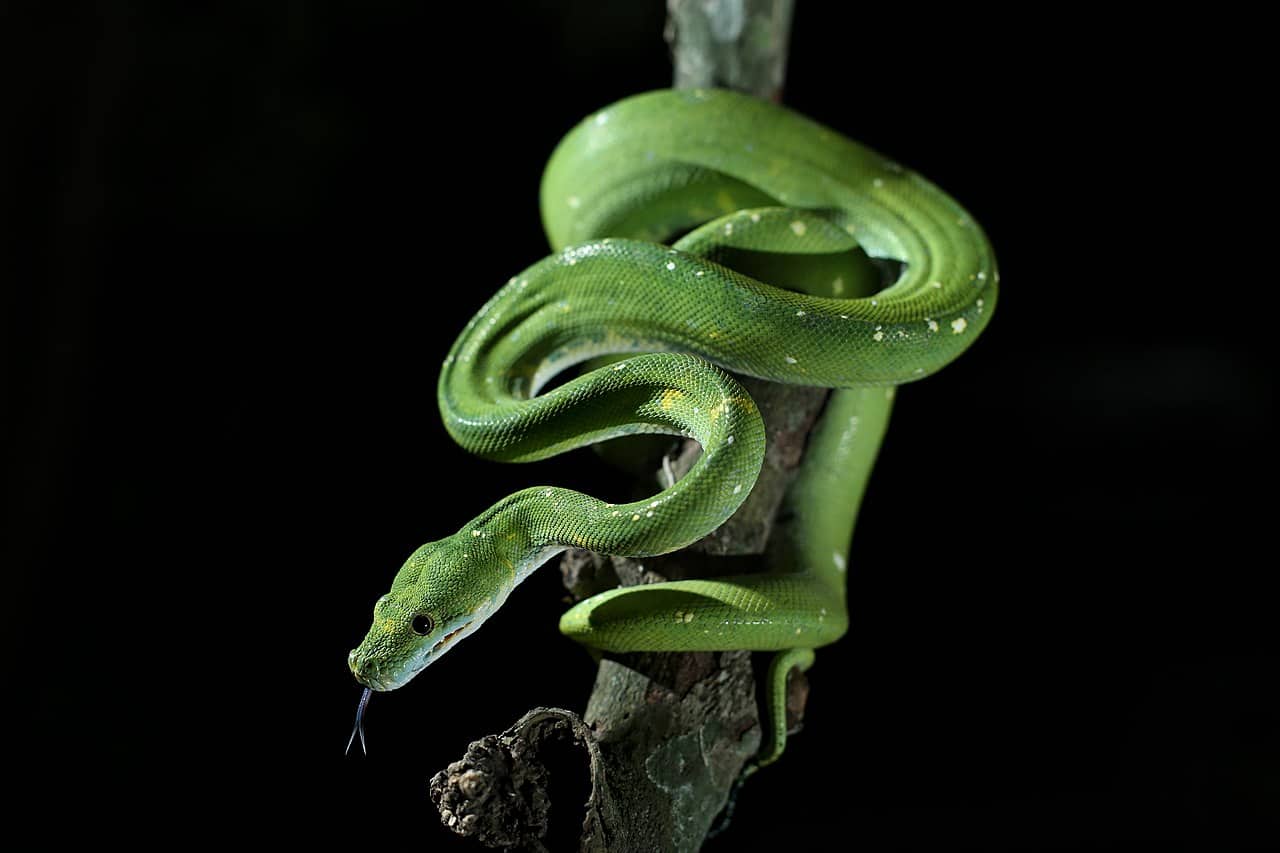
A crushing constrictor of northeast Australia, which reaches a record of 220cm. Green tree pythons inhabit the dense rainforests of Queensland and Papua New Guinea, almost never straying to the grasslands next to forests.
Whether it’s a specific survival strategy or they’re just showing off, we’re not sure, but green tree pythons reach extreme heights in the canopies. A study from Iron Range National Park in Queensland found that while young green tree pythons stayed within 10 metres of the ground, adults regularly ascended to 25 metres or more, one of the most towering records of any snake.
Green tree pythons prey on mammals and occasionally birds, which they ambush from a comfortable nest of coils. They must choose the most optimally angled branch for making sudden lunges, otherwise their prey might dodge and escape. If this branch happens to be 20 metres above the rainforest floor, then so be it.
Green tree pythons ascend so high simply because they can. They have excellent climbing abilities in spite of their bulky weight, and there’s no limits on where they can place themselves in an ambush position. If there’s food shortages lower down, then the green tree python will be dragged higher by default. That’s not all, as if a male scents a female on the highest branches, he could be lured all the way from 0 metres to 20. These scent particles could be blown on the breeze or lingering on surfaces like a leaf.
| 2 | Amazon tree boa |
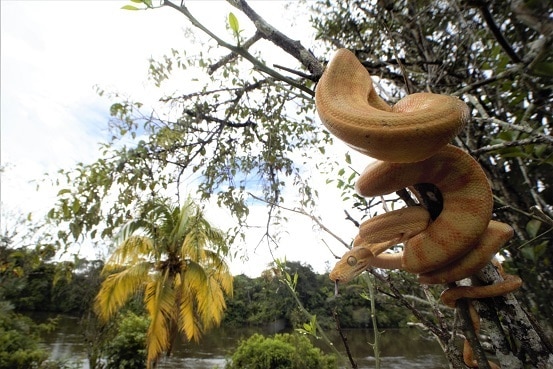
A forest might be a forest, but there’s multiple sublevels within them. You have the earthy soil chambers where ant-eating blind snakes live, hidden from view. You have the forest floor, containing venomous bushmasters and human explorers attempting to tiptoe past them. Then you have the towering canopies, where beams of sunlight shine through, and Amazon tree boas rest peacefully on branches, oblivious to the drama below.
Amazon tree boas measure up to 188cm and are completely non-venomous, preferring to rely on an aggressive temperament for their survival. They range from Brazil to Peru, and appear in isolated tree clumps near farms as well as fully fledged forests. Their body isn’t too twig-like, but they navigate branches with ease, and have been recorded at 25 metres high in the crowns of trees. Amazon tree boas also vary wildly in colour, from grey to brown to neon orange.
The Amazon tree boa has access to areas a human being couldn’t dream of, with excellent climbing skills and no fear of heights. If this snake wants to stay out of sight, then it will, unless people are willing to climb 20 metres high in a swarming rainforest canopy. You could always send a drone up to look at them, but this would probably be swiped down by a monkey at the last second.
| 3 | Brown tree snake |
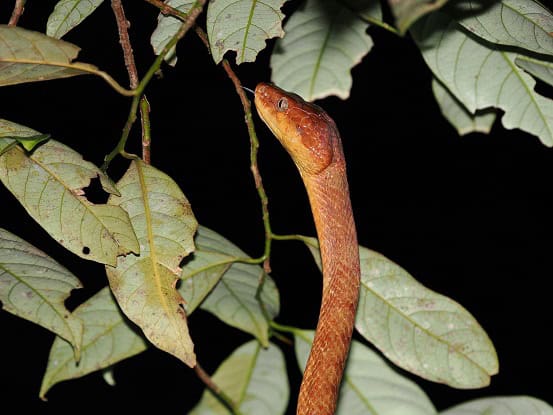
Many forest snakes have a safety switch built into their brains. They know that if they climb too far then a fall would be correspondingly more catastrophic, ending their lives. But the brown tree snake just keeps on climbing, with no fear whatsoever. This is a native Australian species which mainly lives in the forests of Queensland. They’re also a notorious invasive species on Guam, the US-controlled Pacific island, where they’ve wreaked havoc on the native birds (their main prey).
According to a 2022 study on Guam, brown tree snakes prefer lower branches, but regularly ascend to 10-15 metres, with one individual reaching 18 metres. On average, males reached higher perches than females.
These discoveries were purely inadvertent, as the scientists were actually on a quest to map out every possible Boiga irregularis characteristic in their attempts to eradicate them (which have all failed). It’s likely that brown tree snakes reach 20 metres when not being observed.
The brown tree snake is mildly venomous, though no threat to humans. They’re recognisable by their bulging eyes and a fully brown body, measuring 100cm. This snake also inhabits forest edges and more isolated tree clumps, so it gets a superior view to most high-climbing snakes. Brown tree snakes can climb 20 metres high, and not be blocked by a thick jungle canopy like the green tree python. They can see a grassy plain, the sunset, the ocean, or even a group of US government exterminators approaching.
| 4 | South American sipo |
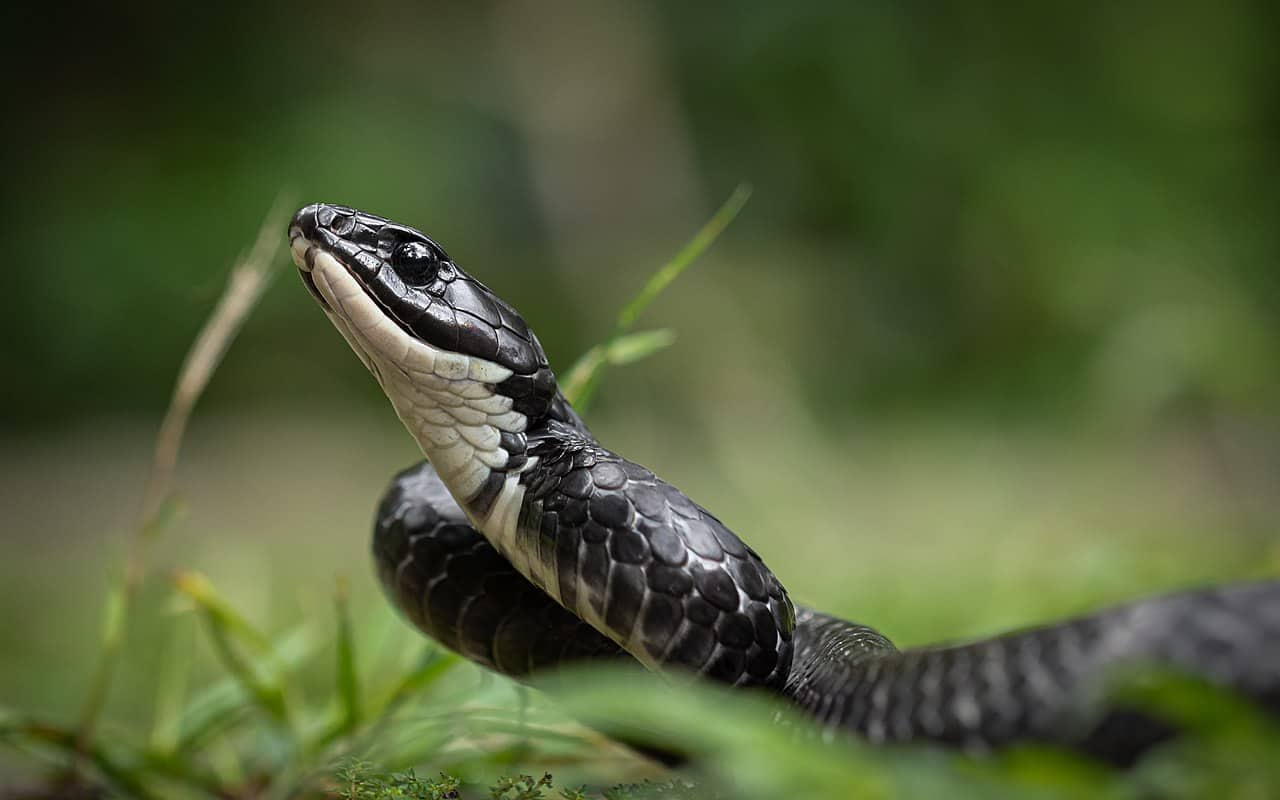
South American sipos are part of the 23-member Chironius family, and are one of the less widespread in territory, but one of the highest tree climbers among the crew. This species is found only in coastal areas of southeast Brazil, including areas near Rio de Janeiro and Sao Paulo. They reach a maximum of 134.5cm, and lack any form of venom. They can’t instantly bite a predator to deactivate the threat, but luckily, the South American sipo has a solution: stay 15 metres above ground.
This is a slow, steadily climbing snake which has no fear about living in high, unstable canopies. They have an unpredictable temperament, and subdue their prey by grabbing them with a couple of loose coils. In a 2021 study featuring 5 family members, also including brown sipos and Brazilian sipos, south American sipos (Chironius foveatus) reached the highest branch perches of all, at 16 metres.
This species mainly preys on Hylid tree frogs. They have a thin body, perfect for crossing between overlapping tree branches. They have a great view of treefrogs hopping around, but seeing humans wandering below is very difficult, as their forests are just so thick. Likewise, it’s hard for humans to spot this snake 15 metres above their head.
| 5 | Stephen’s banded snake |
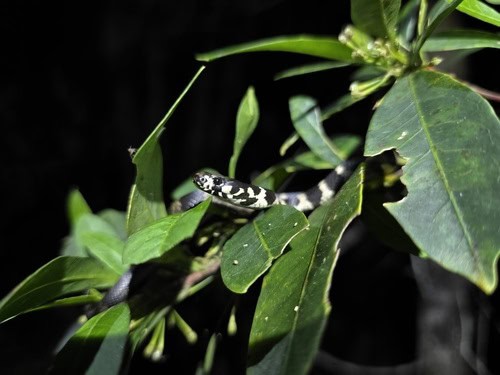
This 120cm, dangerously venomous snake achieves some of the highest branch heights in Australia. They’re native to eastern Australia, and live in remnant forest patches with minimal human influence. Stephen’s banded snakes (Hoplocephalus stephensii) have been recorded at heights of 25 metres above ground, and 20 metres is perfectly common. Rather than open areas, they like to be shielded by foliage like overlapping leaves, to avoid hungry predators swooping in.
Stephen’s banded snake is found exclusively along Australia’s east coast, and they’re especially common near Brisbane. This is not just a high climber, but a likely snake to be found poking its face out from a dark hole in a tree trunk. This species stops feeding for five whole months in winter, during which they stash themselves in tree hollows. Their body temperature has been found to fluctuate wildly, from 11-37C.
Climbing so high means that Hoplocephalus stephensii is a candidate snake to plummet down and land on your head. Luckily, the fact that snakes already have such bad eyesight probably helps them; if they looked down and saw the floor far below, they’d probably have a panic attack and lose their balance. It’s best for everyone that Stephen’s banded snakes have no comprehension that they’re 20 metres high in the air.
| 6 | Blanding’s catsnake |
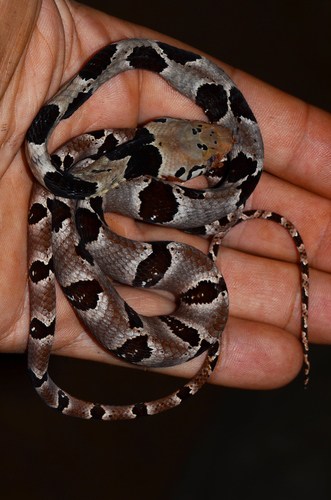
This African snake regularly reaches 15 metres above ground, and rests there for hours with no worries. It rests so high that the forest floor ceases to exist, and its world consists purely of branches and beams of sunlight shining through.
Blanding’s catsnake (Toxicodryas blandingii) is mildly venomous, and moves by night. With less cones and more rods in their retina, creating increased sensitive to minute quantities of life, they can navigate canopies 20 metres high in complete darkness. Blanding’s catsnakes also hunt while in the air, searching for airborne prey like birds and Angolan free-tailed bats. They sometimes drop to the ground, but are easily most at home in branches, with a relatively thin body and elongated tail.
Blanding’s catsnakes live in over a dozen countries, including Nigeria and Guinea, mainly in forests, but also parks. They also have a cousin which is a high tree climber: Toxicodryas vexator, which lives further to the southeast in Uganda and DRC, and is confirmed to reach 30 metres high.
A forest with this species might seem completely empty of snakes, a peaceful place. You might think the rumours were all exaggerated and walk on while whistling. But in reality, the snakes are 15 metres above your head, looking as eerie as ever. Fortunately, Blanding’s catsnakes are alert and nimble, and the odds of one dropping onto your head are minimal (but not quite zero).
| 7 | March’s palm pitviper |
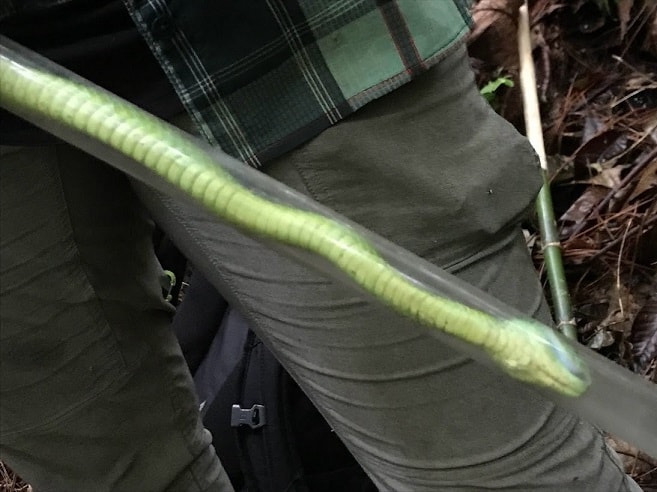
If you ever fell face first into a Honduran rainforest from a helicopter, this is probably the first snake you’d meet. March’s palm pitvipers (Bothriechis marchi) occupy branch perches of 1-2 metres, but also 25 metres if the urge strikes. They can remain at these towering heights for many hours and days.
Bothriechis marchii average at 80cm, and are a cousin of the far more common eyelash viper. This is a central American species which inhabits two countries: eastern Guatemala and western Honduras. They never appear in towns and cities, but might be encountered by villagers lost in their local forest. A 2022 study from Casuco National Park, Honduras, found that they regularly break through 20 metres, and climb far higher as adults than juveniles.
Bothriechis marchi doesn’t climb particularly quickly, moving up trunks carefully and concentrating while they navigate the grooves and ridges of branches. But they just keep going and going, until suddenly, they’re 18.68 metres high. A bushmaster can be lurking below in a pile of leaves, while March’s palm pitviper is above in the canopies, mere metres away, yet in a completely different world. March’s palm pitvipers are vulnerable to birds, yet are a vicious opponent, snapping back and injecting a dose of cytotoxic venom. Check out this video to see one climbing.
| 8 | Bothrops bilineatus |
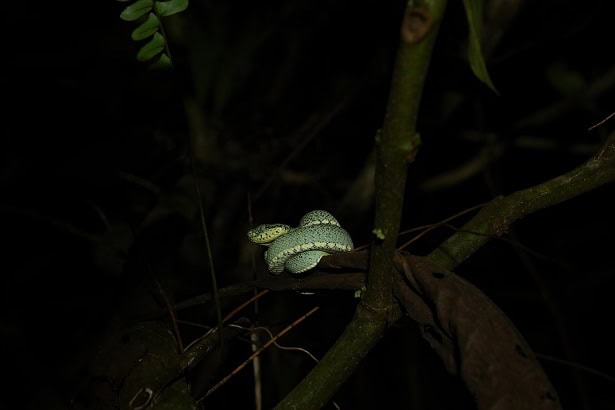
By definition, measuring a snake’s branch height can be difficult if it’s just a casual survey, because they’re so far above your head. In 2021, scientists embarked on a dedicated expedition to analyse the lifestyle of Bothrops bilineatus, AKA the green jararaca. This common species occurs in rainforests all over the Amazon, and is the most tree-faring of the Bothrops family, sticking to a branch and injecting venom into passing frogs. They reach a maximum of 112cm, and are a dangerously venomous species which are capable of striking humans from branches.
Over their 12 month study, the scientists recorded several snakes resting above 10 metres, and one climbed to 20 metres above the mulchy rainforest floor. One Bothrops bilineatus remained on the same branch for 17 days. A separate study in 2019 saw a Bothrops bilineatus rest at 9.4 metres for 3 days straight.
Bothrops bilineatus can move vertically as much as they wish, with no barriers. This is a strict forest species which is never found in open grassland. They prefer the dense interiors of rainforests, where they can eat red snouted treefrogs and Marmorea frogs to their heart’s content.
Being so green, Bothrops bilineatus is hard to spot in any case, but being 10 metres above your head makes it even harder. Through Bothrops bilineatus is fairly hefty, it’s significantly thinner than its ground-dwelling viper neighbours like the jararacussu.
| 9 | Blunt-headed tree snake |
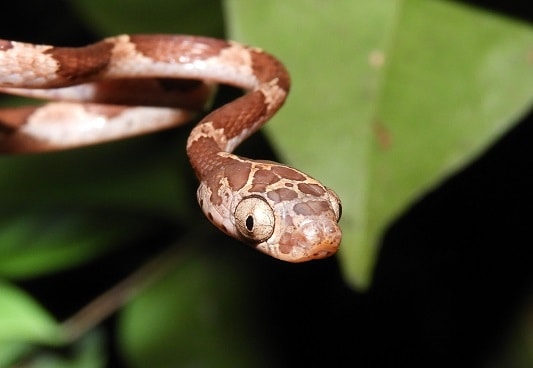
One of Earth’s most fully adapted tree snakes. Blunt-headed tree snakes are extremely widespread in South America, inhabiting all countries except Chile and Uruguay. This nocturnal species strays to the ground sometimes, but spends the majority of its day in trees and vegetation. Imantodes cenchoa can do it all; climbing incredibly high, ascending vertical death-defying trunks, and weaving across super thin branches like a tightrope.
While they usually prefer mid-height vegetation, Imantodes cenchoa will sometimes keep on ascending and ascending. Consequently, this species has been recorded at 30 metres above ground in the towering canopies. Why they climb so high sometimes and not others is a mystery. It’s possible that certain overwhelming lizard scents become too intoxicating for them to resist, drawing them upwards.
Blunt-headed tree snakes reach a maximum of 150cm and are only mildly venomous. Their adaptions to branch life are manifold. There’s sharply angled scales to dig into tree trunks, and bulbous eyes to scan every inch of the forest. Their body is compressed, adding length without making them heavier, allowing Imantodes cenchoa to cross the thinnest of branches. For some reason, their neck is extremely thin. Imantodes cenchoa mainly preys on rainforest lizards, including bridled anoles, pug-faced anoles and border anoles.
Blunt-headed tree snakes know their world inside out. They’ve been found in coffee trees and will lurk calmly between two enormous overlapping rainforest leaves, to grant them camouflage. Imantodes cenchoa is particularly attracted to bromeliads, members of the pineapple family, with tightly packed spirally leaves and a bowl at their centre. They rest in these bowls while they steadily fill with rainwater, taking occasional mouthfuls.
| 10 | Ringed tree boa |
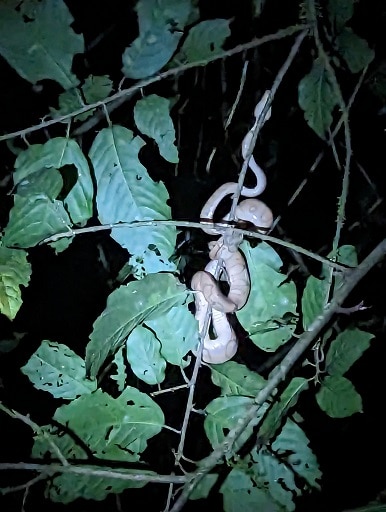
The ringed tree boa (Corallus annulatus) is the rarer, more secretive cousin of the Amazon tree boa. The first difference is that they mainly inhabit central America instead, especially Costa Rica and Panama, plus Colombia. The second difference is that they’re far more rarely sighted, and less flexible, preferring the deepest, darkest forest areas, rather than a simple clump of trees by a school like an Amazon tree boa.
The ringed tree boa is most at home in a primitive world, untouched by humanity. But the indisputable advantage they have is that so far, they’ve been observed at higher heights. In fact, based on current data, the ringed tree boa is the highest climbing snake on Planet Earth.
Ringed tree boas have been observed on tree branches 40 metres above ground. Like the best tree-climbing snakes, they can rest on branches that look absurdly thin relative to their size. It’s one thing being a twig-like snake that slurps up gooey frog spawn, and requires no weight to hunt. But Corallus annulatus is a constrictor and has the body width to match, yet they can still ascend to levels 20 times the height of the average human head.
Ringed tree boas prey on airborne creatures like Canada warblers and Brazilian long-nosed bats. Ringed tree boas can drop down to the ground, but they require trees to survive. What we don’t know is whether they can achieve the real dream: to reach the very top of the rainforest. 40 metres is already an incredibly achievement – could this snake climb as high as you possibly can? Not to hang out in the uppermost canopies, but to breach the top of the rainforest, poke their head out, and witness a neverending sea of green for miles around. If any snake can, it’s the ringed tree boa.
